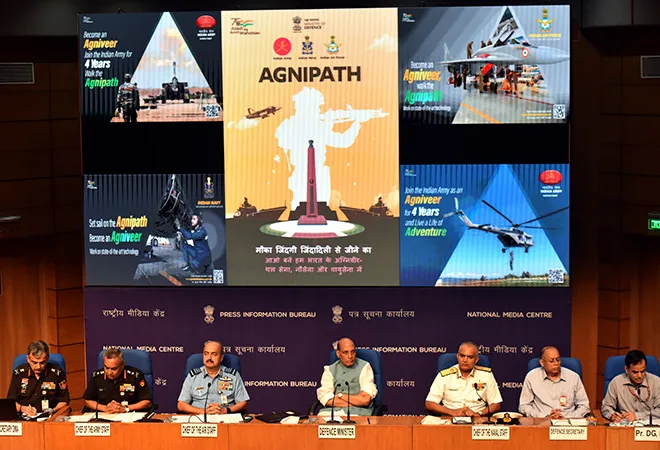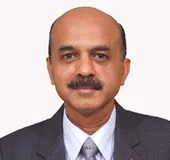-
CENTRES
Progammes & Centres
Location
Does the newly announced Agnipath scheme hold water or are the protests justified?

This piece is part of the essay series, The Agneepath Scheme: Radical or Irrational?
With the government determined to roll out the four-year “Tour of Duty” in the armed forces and create a force of enlisted combatants and non-combatants called Agniveers, the window for debate on the issue must now move to the next plane of how best to ensure its success, anticipate challenges, and have the vision to incorporate mid-course corrections. Veterans and other stakeholders of India’s armed forces are justified in expressing their concern that the scheme has the potential to upset the professional balance in the services. However, they must grant it to the current service leadership that various issues would have been thought through with reasonable clarity, albeit within the constraints of a broader government diktat.
Rather than dwell on the obvious issues such as terms of engagement, remuneration, and post-engagement opportunities in civil society, all of which have been clearly spelt out by the Government of India (GOI), there are two deeper issues at play here and both are interconnected. For some years now, India has been faced with a gargantuan challenge of leveraging its demographic potential, given the huge youth bulge and the growing numbers of able-bodied youth knocking at employment opportunities. While the ambitious “Skill India” initiative was a step in the right direction, it has not paid dividends in terms of creating jobs at the scale that was targeted. Nor has the anticipated boom in the manufacturing sector materialised in the wake of the post-pandemic economic slowdown. Looming in the background has always been the possibility that India’s much-publicised ‘demographic dividend’ can well turn into a ‘demographic disaster,’ a process that seems to have started with the number of unemployed youth ‘up for grabs’ to be exploited by vested interests to create social and communal unrest of various kinds in return for monetary compensation.
India has been faced with a gargantuan challenge of leveraging its demographic potential, given the huge youth bulge and the growing numbers of able-bodied youth knocking at employment opportunities.
By channelling the energies of 40-50,000 able-bodied and enthusiastic youth with a high-school education towards becoming part of a respected organisation that is constitutionally mandated to secure the nation from external and internal threats, there are more positives to take away than meet the eye. India’s armed forces are now representative of a pan-Indian flavour of recruitment; however, the Indian Army has done well to balance the same within the broader ‘regimental ethos’ which forms the bedrock of its fighting potential. Due care must be taken to ensure that the Agnipath scheme does not upset the regimental ethos of the Indian Army even if there is a constituency that suggests that it is time to dismantle it and replace it with a completely pan-Indian regimental system. All three services are likely to face their own set of challenges. While the Indian Air Force (IAF) and the Indian Navy may find it culturally easier to induct the Agniveers, they will have to invest a large chunk of their training resources in skilling and re-skilling the Agniveers given the relatively short turnaround period of four years. On the other hand, the sheer size of the Indian Army leaves enough room for manoeuvre to deploy the Agniveers in combat and supporting functions that are vacant following the ‘freezing’ of recruitment for some years now. Functional absorption of the Agniveers into several disciplines within operational and peacetime ecosystems may be the easy part. The difficult part will be cultural assimilation, particularly in Infantry regiments steeped in the classical regimental system.
Another lament from the armed forces over the years has been that contemporary Indian society is largely unaware and unappreciative of what the armed forces do for the nation. Now when you have a large chunk of the Agniveers recycled into mainstream Indian society along with a smaller chunk of officers belonging to the Short Service Commission after having ‘served,’ it is possible that a better connection emerges between civil society and the armed forces. Sceptics of the scheme argue that discipline is not the only trait that is likely to kick-start a second career for Agniveers and that low-skill coefficients will result in low-grade job opportunities. This is a challenge that the services and the government will have to address with all seriousness in concert with the corporate sector to create a steady supply chain of aligned job opportunities that add to the self-worth of the individual. There will also be a requirement to provide further post-graduate academic opportunities for those Agniveers who demonstrate an inclination to study further after their term of engagement and having acquired their undergraduate degree during their tour of duty.
Sceptics of the scheme argue that discipline is not the only trait that is likely to kick-start a second career for Agniveers and that low-skill coefficients will result in low-grade job opportunities.
There is much-hidden talent in Indian youth, particularly from the rural areas and tier II and III urban areas. Talent spotting within the Agniveer cohort after they have joined can lead to the unearthing of significant combat potential. By a typical law of averages, the services must anticipate that 1-2 percent of any cohort will be outstanding and meritorious of absorption into frontline capabilities of any kind with specialised training, while another 10 percent or so will demonstrate potential for combat/frontline duties This segment could form the lot that is encouraged to stay on along with those who seek retention and come up to the minimum standards that are laid down. While training methodologies for the Agniveers would largely conform to the existing regimen, albeit in a significantly compressed timeframe, adequate emphasis must be laid on military ethos and disciplines including battle craft, military ethics and values, contemporary Indian military history and service specific histories. The next level should be about communications skills, team dynamics, and identification of skill-sets based on scientifically proven aptitude tests for semi-technical trades.
While the announcement by the Union Home Minister that Agniveers will have a preferential entry into the Central Armed Police Forces (CAPF) is laudable, it is too early to assess the fine print of the announcement and its impact. The impact of a four-year tenure has also been widely questioned and not without reason if one looks at the training period, operational weaning-in, consolidation period and finally, a period of meaningful contribution. Some balance between the financial savings and its operational impact may have to be looked at even if it means increasing the tenure to between 5–7 years.
While training methodologies for the Agniveers would largely conform to the existing regimen, albeit in a significantly compressed timeframe, adequate emphasis must be laid on military ethos and disciplines including battle craft, military ethics and values, contemporary Indian military history and service specific histories.
The success of this scheme will rest on the pillars of patriotism and duty towards country and service—no more and no less. Any attempts to politicise the scheme can be disastrous and could result in a polarisation within the armed forces. The political executive and the service leadership owe it to the nation that the scheme achieves its principal objective of leveraging India’s vast human potential for the national good.
The views expressed above belong to the author(s). ORF research and analyses now available on Telegram! Click here to access our curated content — blogs, longforms and interviews.

Air Vice Marshal (Dr)ArjunSubramaniam (Retd) is a fighter pilot from the IAF a military historian air power analyst and strategic commentator who is currently a ...
Read More +